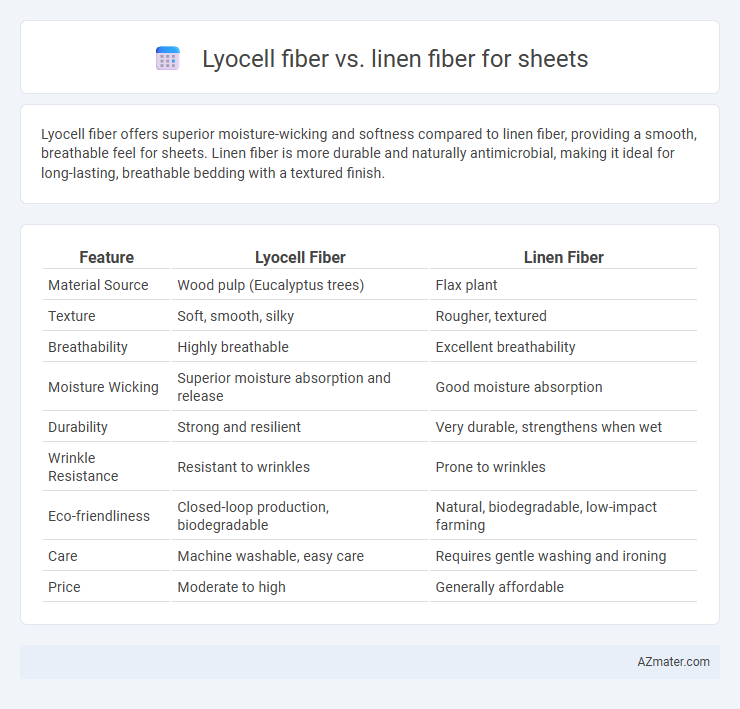Lyocell fiber offers superior moisture-wicking and softness compared to linen fiber, providing a smooth, breathable feel for sheets. Linen fiber is more durable and naturally antimicrobial, making it ideal for long-lasting, breathable bedding with a textured finish.
Table of Comparison
| Feature | Lyocell Fiber | Linen Fiber |
|---|---|---|
| Material Source | Wood pulp (Eucalyptus trees) | Flax plant |
| Texture | Soft, smooth, silky | Rougher, textured |
| Breathability | Highly breathable | Excellent breathability |
| Moisture Wicking | Superior moisture absorption and release | Good moisture absorption |
| Durability | Strong and resilient | Very durable, strengthens when wet |
| Wrinkle Resistance | Resistant to wrinkles | Prone to wrinkles |
| Eco-friendliness | Closed-loop production, biodegradable | Natural, biodegradable, low-impact farming |
| Care | Machine washable, easy care | Requires gentle washing and ironing |
| Price | Moderate to high | Generally affordable |
Introduction to Lyocell and Linen Fibers
Lyocell fiber, derived from sustainably sourced eucalyptus wood pulp, offers exceptional softness, moisture-wicking, and breathability for premium sheets. Linen fiber, made from flax plants, is highly durable, naturally hypoallergenic, and has excellent thermal regulation, making it ideal for bedding in both warm and cool climates. Both fibers provide eco-friendly alternatives with unique textures, where lyocell's smooth finish contrasts with linen's crisp and textured feel.
Fiber Origin and Production Processes
Lyocell fiber is derived from sustainably harvested eucalyptus trees using a closed-loop solvent spinning process that recycles almost all chemicals, ensuring minimal environmental impact. Linen fiber originates from the flax plant and undergoes traditional retting and milling methods, which are more labor-intensive and utilize water and natural enzymes to extract and soften the fibers. The modern, eco-friendly production of Lyocell offers greater consistency and sustainability compared to the more variable, natural processing of linen fibers.
Environmental Impact Comparison
Lyocell fiber, produced from sustainably sourced wood pulp using a closed-loop process, boasts significantly lower water usage and chemical waste compared to traditional linen fiber derived from flax plants, which often requires extensive pesticide application and intensive water consumption during retting. The biodegradability of both materials is high, but Lyocell's manufacturing process reduces soil degradation and energy consumption, making it a more environmentally friendly option for bed sheets. Lifecycle assessments reveal Lyocell sheets typically generate less greenhouse gas emissions and have a smaller overall ecological footprint than linen counterparts.
Durability and Strength in Sheets
Lyocell fiber offers superior durability and strength for sheets due to its tightly bonded cellulose fibers, which resist wear and maintain fabric integrity over time. Linen fiber, derived from flax plants, is exceptionally strong and becomes softer and more durable with each wash but may show natural wear faster under heavy use. Lyocell sheets provide enhanced tensile strength and resistance to pilling compared to linen, making them ideal for long-lasting bedding.
Comfort and Breathability Factors
Lyocell fiber offers exceptional moisture-wicking properties and a smooth texture that enhances comfort, making it ideal for sensitive skin in bed sheets. Linen fiber provides superior breathability and natural temperature regulation, keeping sleepers cool and dry, especially in warm climates. Compared to linen, Lyocell sheets tend to feel softer and more pliable, while linen excels in durability and airflow.
Moisture Wicking and Absorption
Lyocell fibers exhibit superior moisture-wicking and absorption capabilities compared to linen fibers, efficiently drawing moisture away from the skin to keep sleepers dry and comfortable. The hydrophilic nature of Lyocell allows it to absorb up to 50% more moisture than cotton, enhancing breathability and promoting faster evaporation. Linen, while breathable and naturally moisture-absorbent, tends to retain moisture longer, which may lead to a damp feel during prolonged use.
Softness and Skin Sensitivity
Lyocell fiber offers exceptional softness and a smooth texture ideal for sensitive skin, as it is hypoallergenic and moisture-wicking, reducing irritation and promoting comfort. Linen fiber, while breathable and durable, has a coarser feel that may cause slight roughness for individuals with delicate skin. Sheets made from Lyocell are preferred for those seeking a gentle, soothing fabric that maintains softness after washing.
Maintenance and Care Requirements
Lyocell fiber sheets require gentle washing in cold water with mild detergent to preserve their softness and moisture-wicking properties, while avoiding bleach and high heat drying to prevent damage. Linen sheets demand a more robust washing routine, tolerating higher temperatures and requiring less delicate handling, but benefit from air drying or low heat to maintain fabric strength and reduce shrinkage. Both fibers improve in softness with repeated washing, yet Lyocell's low-maintenance nature suits those seeking easy care, whereas linen's durability appeals to users comfortable with more intensive upkeep.
Cost and Value Analysis
Lyocell fiber sheets typically offer a higher initial cost than linen sheets due to their advanced manufacturing process and eco-friendly production methods. However, Lyocell provides superior softness, moisture-wicking properties, and durability, contributing to better overall value and prolonged lifespan compared to linen. Linen sheets, while more affordable upfront and known for breathability and natural texture, often require more maintenance and may wear out faster, impacting long-term cost-effectiveness.
Which Fiber is Best for Sheets?
Lyocell fiber offers superior moisture-wicking and breathability compared to linen fiber, making it ideal for cooling and comfortable sheets. Linen fibers provide exceptional durability and a naturally textured feel, favored for their strength and longevity in bedding. For the best balance of softness, sustainability, and temperature regulation, Lyocell sheets are often preferred over linen, especially in warmer climates.

Infographic: Lyocell fiber vs Linen fiber for Sheet
 azmater.com
azmater.com